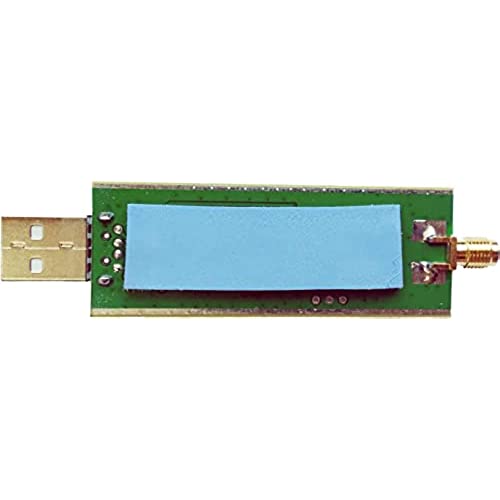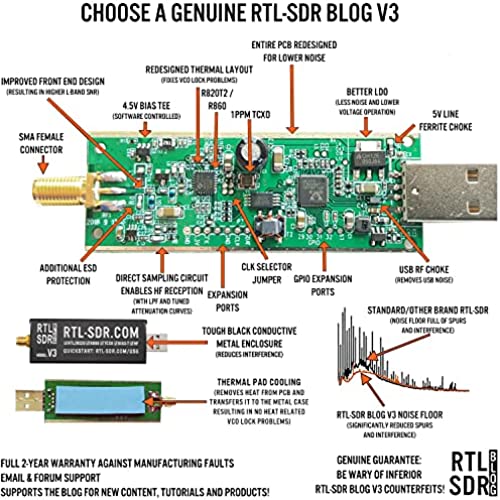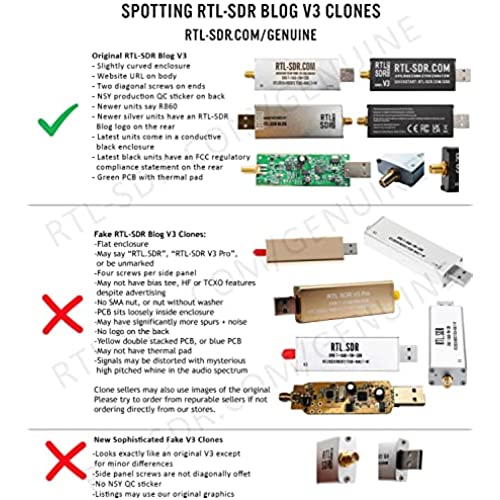













RTL-SDR Blog V3 R860 RTL2832U 1PPM TCXO SMA Software Defined Radio (Dongle Only) (Black)
-

M1K3 FR0M D3TR01T
> 3 dayOK, Im totally new to all of this so I bought this dongle. I went to the quickstart setup guide listed on the outside of this device. Like the 3rd step said to go to airspy website and download their SDRsharp software. The website (as of 5/20/2019) has been dead all day. Crud! I tried the manual driver downloads and the Zadig download thing which downloaded, but theres no actual software radio since you still have to get a program to run the interface. So, I poked around other places and got some even cooler (?) software to run this thing: SDR Console v3 from sdr-radio dot com. Downloaded, it took a while since it was 137MB. I plugged in this dongle. Nothing happened. Tried it over and over. Then I plugged it into a regular USB port on my computer (instead of one labeled SS and I heard the usual bing-bong Windows 10 has detected a new device being plugged in. Cool! I started up the SDR Console v3 software. It asked what dongle I was using and I chose RTL dongle or something very similar (I did NOT select the TCP version, its the USB version). BAM: nice radio static. It was working!!!!!! So then I thought: I have no antenna, just a dongle at this point. Also, I have no idea what any of this is. So it was RTL Dongle-R820T in a new window > select Bandwidth = 2MHz (for no reason) > click Start > static! Then I went to the middle, left side of screen and clicked on BFM (Broadcast FM). In the upper left part of screen there is a Receive box labeled RX1. You click either above or below each frequency number to change it higher or lower. Im in Detroit and a strong radio station is 101.1 FM WRIF radio. So I got that input into the type left. Still static...so I bent a metal paperclip straight and held it up to the hole in the USB dongle meant for antenna: BAM I COULD HEAR THE FM RADIO STATION REALLY WELL!!!!!!! Then up on the screen popped another window that said 101.1 Van Halen and it was giving me band name and song title information of what the station was playing!!!!! So, thats how you get up and running in under 5 minutes. After this you can get a Ham it up PLUS box to plug in to this that converts ELF and VLF signals if you want to listen to military submarine base signal (cosmic rays and solar flares interfere with these so you can detect space and atmospheric events this way). Plan on buying various SMA adapters and antennas and adapters to plug those antennas into sma connectors. Right now Im happy with my scotch tape/paperclip antenna. Im still waiting for the other stuff to arrive (Ham It up PLUS converter, antennas, wire to wind my own 2 square vlf antenna, fm filter (glad I didnt have that working while I was testing, lol!), a powered lo-noise filter. These add-ons can possibly be powered by following the RTL websites guide to turning on Bias Tee which I *think* puts electricity through the device to power any add-on boxes you add to this thing (not necessary, but possibly fun). WARNING: I did get the Zadig software to work and did the replace driver step BEFORE I got the SDR Console software downloaded and running, Im not sure if that helped or made no difference. So, I took the paperclip away and just touched the outside of the dongle with thumb and index finger: it got reception on that station too! Sounded great and on the screen it said American Bad Ass by Kid Rock, so its getting the digital information from the station in addition to the music! With no antenna! So, in the SDR Console software you can pick all sorts of bands: AM, FM, SAM, ECSS-L/ECSS-U, CW-U, CW-L, GBM, NFM, WFM, LSB, USB, DSB, Wide-L, Wide-U. Each one of these will require a different antenna plugged into the dongle: some just a few inches of thin wire or paperclip...some might need 30 tall coax, lol. If you add a Ham It up PLUS box it upconverts a lot more bands to be listenable, but I think you have to tune the software radio to 125MHz...and then you can listen down to ULF, VLF, LF, MF and HF frequencies. On Amazon I ordered one of those (the cheaper circuit board only) and a blue metal box to put it in, along with some other junk that Im not sure if Ill need, but itll be fun. So, thats how I went from ZERO radio experience to listening (at least to FM) with my dongle. Oh, the dongle gets pretty darn HOT to the touch. Click helpful if this helped you. Im pretty good at updating reviews with helpful information--give me a week or two to play with this thing and the other accessories I bought. I attached a blurry photo showing the nice interface and me holding my paperclip antenna> You can see I set the upper left frequency box to 101.1. The middle left box has the BLM broadcast FM option yellow click highlighted. The bottom left box has a 250hz filter selected (for no real reason, it was just on). To the left of my hand a block box says ON 101.1 One Metallica showing the Metallica song One was playing. AWESOME!!! Now Ill just be researching other frequencies and their antenna requirements and buying or hand-making various antennae for fun. Once I get the upconverter (Ham It Up PLUS) Ill make a 2 square VLF antenna which is super-easy. Get a 2 picture frame and wrap a wire around it 40-50 times or 120 times depending on which website Im to believe, either way: super simple. Oh, THIS DONGLE ONLY RECEIVES...you cant transmit with it. Although I believe if you do get a transmitter of some the Ham It Up Plus converter does support transmitting down to 300hz. Not sure if thats wise of legal or whatever, but this dongle is for listening only--which is fine. Hope this helps total newbies! Mike from Detroit.
-

Jay Dub
> 3 dayI have 2 of these units. I was surprised at how hot they run. I always thought the heat would kill them and here I am a year after buying them and I have 2 dead units. They do not hold up well over the long term. Other than their short life theyve worked well as they feed a private audio stream of P25 communications.
-

joe-maryland
> 3 dayThis is like a singing pig, it isnt very good but the amazing thing is it can sing at all. I am reviewing the HF side of this, on VHF and above it seems as good as any of the cheap dongles. For HF it works in direct sample mode, but not that well. I did get my moneys worth, so no complaints, but we all have to know a $20 or so HF receiver is not going to be very good. I will probably move this to VHF and above duty soon.
-

Jim or Dot
> 3 dayWorks great. As advertised. This is the most fantastic device I have used in a very long time. This hardware device enables your computer to see radio signals. Associated software enables you to process (tune) those signals in a variety of ways. To be able to continuously tune 500 KHz to 1.7 GHz is astounding in itself. Throw in a RF Spectrum Analyzer, Audio Spectrum analyzer and assorted filters and it is mind blowing. And the software is free (donations accepted). This is incredible. To do this a few years ago would have cost tens of thousands of dollars. If there were 10 stars I would pick 10 stars. Dont expect a simple thing. Using this device involves unlimited options and radio/science and thus it is not necessarily intuitive :)
-

Alysha Mosciski
> 3 dayProduct as described.
-

Androidfurur
03-06-2025It heats up a lot, its like cooking an egg, and its deaf. For now, Im investigating. But I thought it was better than what was described. I wouldnt buy it again
-

Paul
> 3 dayThere are many SDR units that work from about 30MHz to cover FM broadcast, TV and more. There are quite a few that are said to work at lower frequencies, but dont. After a simple change of settings, it receives AM broadcast just fine.
-

Jorge Sainz
> 3 daydo it obs
-

Shawn
01-06-2025Quick to setup and easy to use. It works well with the correct antenna and does an excellent job. I hear air traffic control at 120 miles away with just a short antenna inside the house. It does get hot, very hot, but not too hot to handle. It doesnt seem to drift frequency even when it does get hot.
-

saveitforparts
> 3 dayI have this on my roof in an outdoor enclosure hooked to a Raspberry Pi, SAWbird NOAA amp and QFH antenna. It works great for receiving NOAA and Meteor satellites. Its been running essentially all summer (on a schedule from the Pi), and has lasted through some pretty extreme heat waves. Ive also used this with a laptop for radio scanning and other RF / Ham experiments. I would definitely buy this again, in fact I have a second one as well, this is a great brand/model! Very cool way to learn about radio and communications, and a step up in quality, performance, and features compared to the cheaper models.
